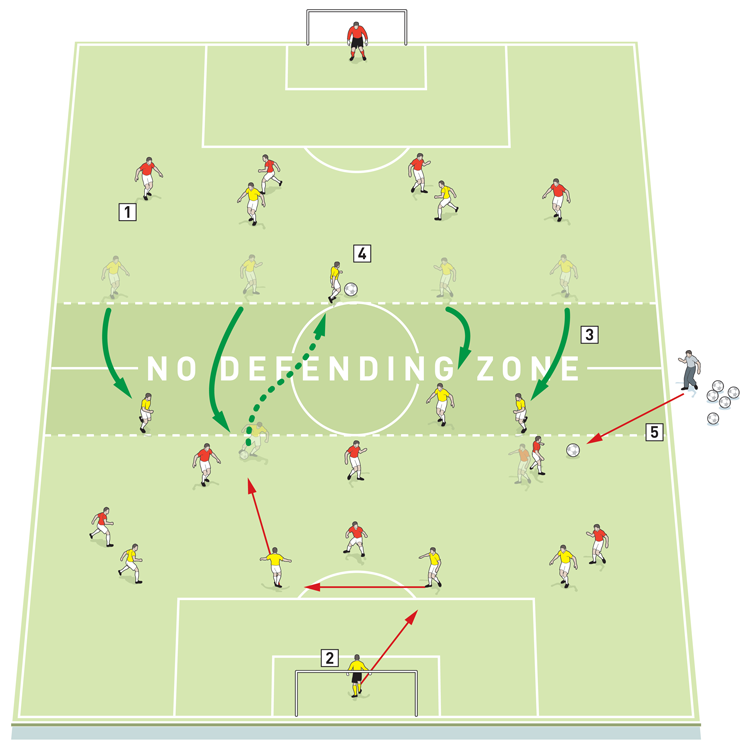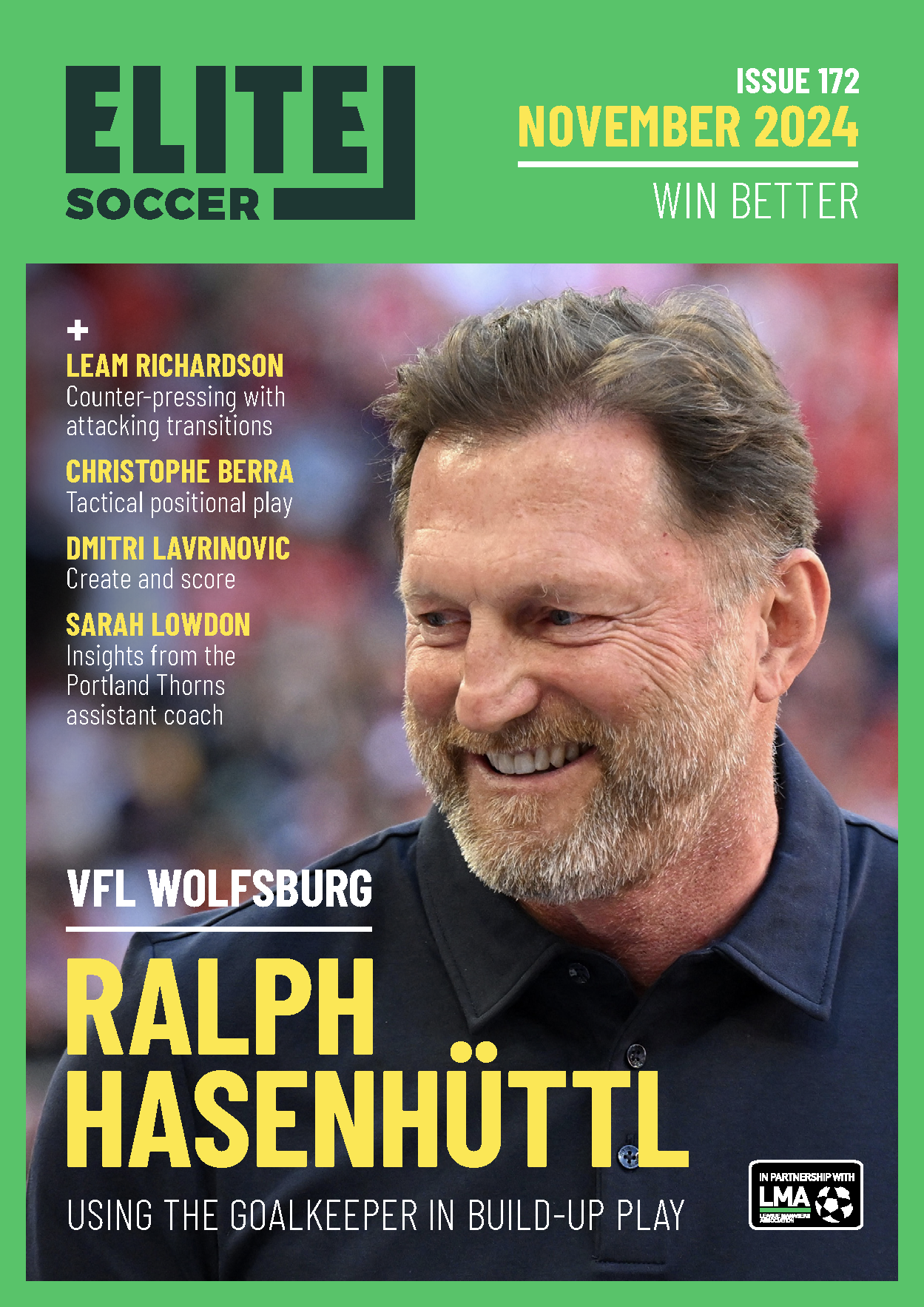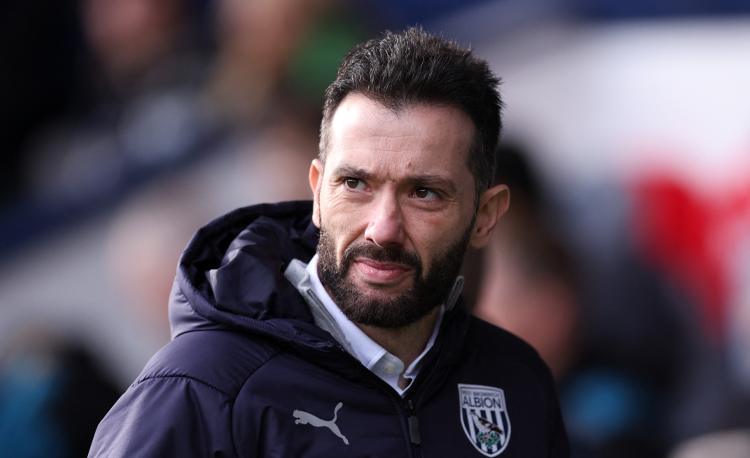You are viewing 1 of your 1 free articles
Attacking with an overload
This session examines how we coach a player technically and tactically when attacking or counter attacking in overload situations.
| Area | Up to full pitch |
| Equipment | Balls, bibs, cones, 2 full size goals |
| No. of Players | Up to 20 players + 2 goalkeepers |
| Session Time | 2v1 attacks: 15mins, 3v2 attacks: 20mins, 6v4 attacks: 20mins |
This session examines how we coach a player technically and tactically when attacking or counter attacking in overload situations.
Technically we want to encourage fast attacking in these situations. It is important to practise this because it improves the speed of attacks in scenarios that appear regularly in matches – the attacking team regaining possession and aiming to create space, passing the ball quickly, then playing to a target player to score.
Tactically we are looking to create overload situations in the small-sided game, where fast attacks become 6v4 in favour of the attackers.
The session is also good for working with defenders – their task is to organise well, stay alert and aim to regain possession as quickly as possible.
What do I get the players to do?
2v1 attacks
We start the session with a high intensity 2v1 drill to encourage fast attacks and counter attacks. We set up an area of 40x30 yards with a goal and goalkeeper at each end. We’re using 12 outfield players split into six pairs, starting as shown [1].
1

2. A second white player now enters the field and the whites attack the opposite end in a 2v1 against one black defender
3. Once the white attack has finished, the black pair immediately attacks the next defender at the other end
Continue to attack in the same manner, making sure each player has a turn at defending and attacking
Play begins with the yellow pair at the bottom attacking one white in a 2v1 and attempting to score a goal. The second white is waiting by the side of the goal at the top end. After the first attack is finished and the yellows have left the field, the second white player immediately steps in to join his partner in attacking the one black player who has entered at the bottom end.
Once the white attack has finished, the two blacks immediately attack the next defender in a 2v1. Continue to rotate through the colours in this manner, ensuring all players have a turn as the sole defender.
We want to see players attacking at maximum pace, with the man on ball driving at the defender in the 2v1. The other attacker in the pair must stay onside and should make space to receive the ball.
Play four blocks of three minutes.
3v2 attacks
The session progresses with a high intensity 3v2 drill that further reinforces the theme of fast attacks and counter attacks. We set up in an area of 40x40 yards, with a goal and goalkeeper at each end. We’re using 14 players, starting as shown [2].
2

2. Play starts with one of the two yellow attackers passing to the coach, who plays across to the other advancing yellow
3. The yellow passes up to the striker. Once the striker touches the ball, the two black defenders become active, making it 3v2 in favour of the attackers
4. Once the attack is dead, the next waiting pair at the top (the reds) play a starting pass to the coach and attack with the white striker at the bottom end in a 3v2
Two black defenders and one white striker are deployed in each half, along with two coaches (or servers). A further two pairs wait their turn to join the play at each end. The two yellows at the bottom start play with a pass to one of the coaches on the halfway line and then both yellows make runs up the pitch. The coach plays the ball back to the other yellow, who passes up to the white striker. Both yellows make runs into the other half and, once the striker has touched the ball, the two black defenders become active, making it 3v2 in favour of the attackers.
Once the first attack on the top goal is finished, the two waiting reds launch an attack on the bottom goal in exactly the same manner, starting with a pass to the coach on the halfway line.
Continue the attacking rotation for four blocks of four minutes, ensuring all players give maximum effort.
6v4 attacks
This practice is aimed at getting players to transition from defending to attacking at speed and it will create 6v4 attacking overloads.
We set up on a full size pitch with a goal and goalkeeper at each end. A ‘no defending zone’ the width of the centre circle is marked out across the pitch. We’re using 20 outfield players, divided into two teams of 10 and set up in a 6v4 in each half in favour of the attacking team. The reds line up in a 4-3-3 formation and the yellows are 4-4-2.
Play starts with a pass out from the goalkeeper of the yellow team. In the build up to an attack, four yellow midfielders can drop back over the halfway line to help, giving the team an 8v6 advantage in that half, as shown [3].
3

2. Play starts with a pass from the keeper
3. Four yellow midfielders can temporarily drop into their defensive half to help build up play from the back
4. If the yellows work the ball across the halfway line, they can attack the reds with a 6v4 overload in that half
5. The coach then plays a second ball into the red attackers, so 6v4 attacks are being played at both ends
If the reds win the ball by pressing high, the four yellow midfielders retreat back into their own half, giving the reds back their 6v4 attacking advantage as they try to score. However, if the yellows manage to work the ball over the halfway line without losing possession, they can attack the reds in a 6v4 themselves – but they must play quickly to take advantage of the overload.
If the yellows cross the halfway line with the ball, the coach immediately plays a second ball into the red attackers in the other half, meaning that 6v4 attacks are underway simultaneously at both ends.
After the ball goes dead in both attacks, regain set-up shape and this time the red goalkeeper starts with the ball. It is now the reds that must build up from the back, cross the halfway line and create a 6v4 attack. If the reds succeed in getting the ball across the halfway line, this time the coach feeds the second ball in to the yellow attackers to create a 6v4 at both ends again.
What are the key things to look out for?
Players should maintain a high tempo to ensure pressure is placed on the transitions for both defenders and attackers.
For technique, speed and accuracy of pass is important, particularly the pass made to the target man.
Tactically players should be aware of movement to make passing easier at speed and to create space for team mates.
For the defending team, we’re looking for them to press quickly and be compact.
Players should communicate with team mates to coordinate attacks.
Related Files
Editor's Picks
Using the goalkeeper in build-up play
Pressing principles
Intensive boxes drill with goals
Penetrating the final third
Creating and finishing
My philosophy
Pressing initiation
Compact team movement
Defensive organisation
Coaches' Testimonials

Alan Pardew

Arsène Wenger

Brendan Rodgers

Carlos Carvalhal

José Mourinho

Jürgen Klopp

Pep Guardiola

Roy Hodgson

Sir Alex Ferguson

Steven Gerrard
Related
Coaches' Testimonials

Gerald Kearney, Downtown Las Vegas Soccer Club

Paul Butler, Florida, USA

Rick Shields, Springboro, USA

Tony Green, Pierrefonds Titans, Quebec, Canada
Join the world's leading coaches and managers and discover for yourself one of the best kept secrets in coaching. No other training tool on the planet is written or read by the calibre of names you’ll find in Elite Soccer.
In a recent survey 92% of subscribers said Elite Soccer makes them more confident, 89% said it makes them a more effective coach and 91% said it makes them more inspired.
Get Monthly Inspiration
All the latest techniques and approaches
Since 2010 Elite Soccer has given subscribers exclusive insight into the training ground practices of the world’s best coaches. Published in partnership with the League Managers Association we have unparalleled access to the leading lights in the English leagues, as well as a host of international managers.
Elite Soccer exclusively features sessions written by the coaches themselves. There are no observed sessions and no sessions “in the style of”, just first-hand advice delivered direct to you from the coach.









